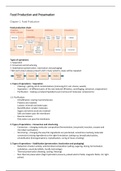Food Production and Preservation
Chapter 1. Food Production
Food production chain:
Types of operations:
1. Separation
2. Conversion and structuring
3. Stabilisation (preservation: inactivation and packaging)
! Not every step is always present and in many systems, steps will be repeated
1. Types of operations – Separation
- Cleaning – getting rid of contaminations (removing dirt, soil, stones, weeds)
- Separation – of different parts of the raw material (filtration, centrifuging, extraction, evaporation)
- Purification – making a product/ingredient pure (removal of molecular components)
1.3. Purification:
- Ultrafiltration: sieving macromolecules
Proteins are retained
Lactose, minerals and water pass
- Nanofiltration: smaller molecules
Sugars and amino acids are retained
Salts and water pass the membrane
- Reverse osmosis
Only water can pass the membrane
2. Types of operations – Conversion and structuring
- Conversion – changing molecular composition (fermentation, (enzymatic) reaction, enzyme and
microbial inactivation)
- Structuring – changing the way that ingredients are positioned, sometimes involving molecular
conversions (mixing ingredients to the right formulation, baking e.g. bread/cake/cookies,
emulsification (homogenisation), crystallisation, curing of meat, smoking)
3. Types of operations – Stabilisation (preservation: inactivation and packaging)
- Reduction of water activity, antimicrobial composition (salting, sugaring, drying, fermentation,
acidulation, causticity=alkalic, hurdle technology)
- Thermal preservation (heating, cooling, freezing)
- Non-thermal preservation (high hydrostatic pressure, pulsed electric fields, magnetic fields, UV, light
pulses)
,Soy beans are rich in oil and proteins:
Direct use:
- Soy milk > tofu
- Soybean oil > margarines, shortenings, mayonnaise, salad dressings, frozen foods, imitation dairy,
meat products, bakery
- Fermented products > soy sauce, fermented bean paste, natto, tempeh
Refined use:
- Soy Protein Concentrate (SPC) > 70% protein
- Soy Protein Isolate (SPI) >90% protein
Conclusion: Production processes:
- Understand the intention of a process step
- Relate the composition of the processed product to the applied process steps/unit operations
- Be able to transform a process description into a flow diagram and vice versa:
Block chart (visualize process):
Visio diagram (visualize process + equipment)
Sankey diagram (visualize process + size flows)
Process system analysis – Recovery:
Yield: with reaction stoichiometry:
,Footprinting: what input is needed for a product:
Overall footprinting of inputs (using equivalence):
Overall footprinting of outputs (using equivalence):
Trends in food production:
- Trend towards complete use of raw materials (total use bio-reining, new components for new product
functionality, sustainability: maximizing returns and component recoveries)
- Centralization of food processing
Central processing: Why not just produce and process locally? Economy of scale:
- Safety and peripheral infrastructure (central labs, control and expertise easier maintained)
- Cost of equipment (production volume rises faster than production costs: larger vessels (2x size = 8x
volume), lines and pipes (2x diameter = 16x troughput))
- Use of energy, water and raw materials (larger scales enable better re-use of energy, new and other
products possible from former waste streams, investment in new technologies, automation)
- Easier marketing
, William’s 0.6 rule – When the capacity of a factory increases by a factor 2, the costs only increase roughly by a
factor of 1.6:
Summary chapter 1:
Chapter 2. Food Preservation and Hurdle Technology
Food preservation techniques:
Reaction rates of changes in food, such as growth of mo’s, lipid oxidation, enzyme activity and Maillardation in
general increase with increasing aw. In general, a lower aw results in a higher stability.
Water activity:
- Pure water aw = 1
- Solution aw < 1
Solute activity:
- Pure solute as = 1
- Solution as < 1
Water activity is not the same as the water concentration.





